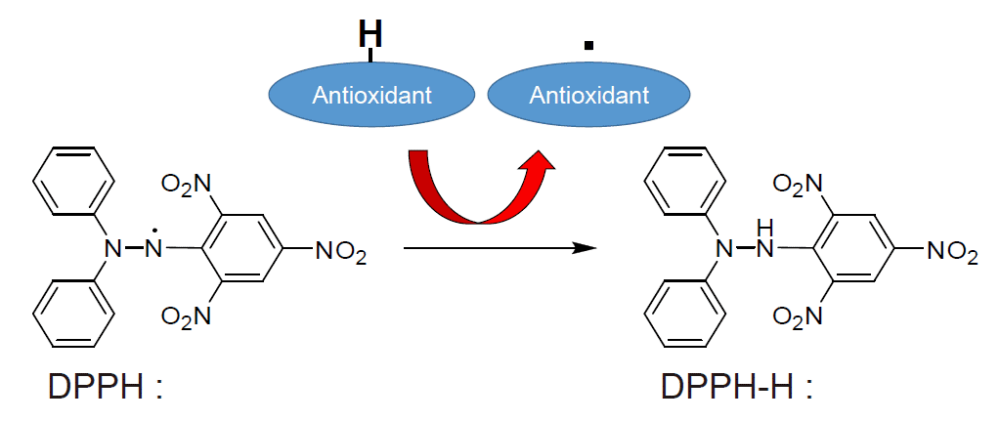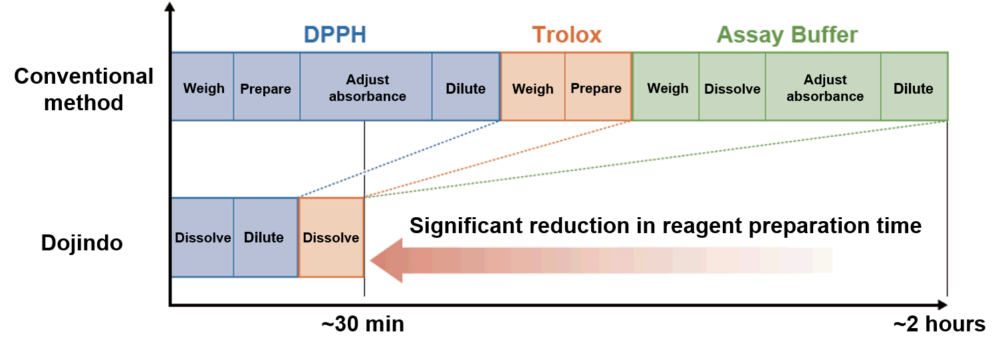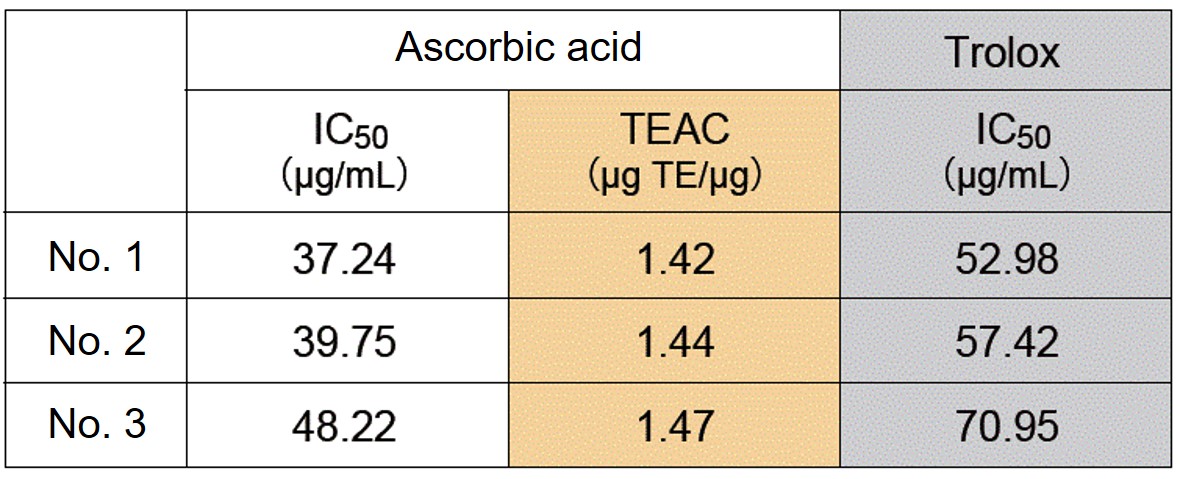DPPH Antioxidant Assay Kit

Antioxidant Ability Assay
- Reproducible detection of antioxidant capacity assay using a DPPH-method
- Significant reduction in reagent preparation time
- High reproducibility
- Comparison with a conventional method
-
Product codeD678 DPPH Antioxidant Assay Kit
| Unit size | Price | Item Code |
|---|---|---|
| 100 tests | Find your distributors | D678-10 |
| 500 tests | Find your distributors | D678-12 |
| 100 tests | ・DPPH Reagent ・Trolox Standard ・Assay Buffer |
×1 ×1 11 ml×1 |
|---|---|---|
| 500 tests | ・DPPH Reagent ・Trolox Standard ・Assay Buffer |
×5 ×5 55 ml×1 |
Description
Changes in antioxidant capacity of the body are involved in the development of various diseases and health problems. As a result, this increases expectations for foods with antioxidant activity (antioxidant foods). Kochi University’s Shimamura et al. have developed a method using DPPH (2,2-Diphenyl-1-picrylhydrazyl) for evaluating antioxidant activity with little difference between measurement facilities1). This product uses a method including a microplate based on the report of Shimamura et al. By manualizing the DPPH measurement method and producing a kit of stable and constant quality, we were able to reduce data variability and complexity of reagent preparation, which has experienced issues until now.
1) T. Shimamura et al., Anal. Sci., 2014, 30, 717 – 721

Manual
Technical info
DPPH and Trolox are unstable in solution. Please prepare immediately before using.
DPPH content needs to be checked by measuring absorbance.
Reagents necessary for measurement are inlcuded and subdivided. Begin experiments immediately with simple preparation before measurement.
(Please use sonication to dissolve the DPPH Reagent.)

Measuring method
After preparing the reagent, add the reagent and sample to the 96-well microplate and react for 30 minutes.

Comparison with a conventional method
When measuring antioxidant activity with DPPH, the pH and solvent concentration in the solution affect the measurement. This product uses protocols and analysis methods to minimize these effects.
Effect of pH and sample solvent
 The assay buffer provided with the product allows measurement at a certain pH.
The assay buffer provided with the product allows measurement at a certain pH.
The sample volume is set to 1/10 (20 μL) of the total reaction solution. The kit is optimized so that there is no difference in the measured value even if the sample is dissolved in water or ethanol.
IC50 Value Variation

If the antioxidant capacity of a sample is analyzed using only IC50 values, the data will vary slightly in the different measurement conditions. By measuring the sample and standard substance (Trolox) simultaneously and calculating the antioxidant capacity as the Trolox equivalent activity value (TEAC), highly reproducible measurement values can be obtained.
TEAC (μg TE/μg) = Trolox IC50 (μg/mL)/ Sample IC50 (μg/mL)”
Measurement Example
Confirming differences between facilities
At three facilities, antioxidants were measured by the DPPH method.
Gallic acid, catechin, and morin (known antioxidants) were measured using a cuvette spectrophotometer and calculated as a Trolox equivalent activity value (TEAC).

There was nearly no difference in measured values between the three facilities.
Reference: T. Shimamura et al., NipponShokuhin Kagaku Kogaku Kaishi, 2007, 54, 482 – 487.
Comparison between microplate and cuvette

Similar to the above experiment, three antioxidants were measured using a microplate and calculated as Trolox equivalent activity values. As a result, almost the same measurement results were obtained. This kit uses a microplate for measurement.
References
| Reference No. | Samples | Citation |
|---|---|---|
| 1 | Compounds (Aromatic polyketides) |
Enjuro Harunari, Chiaki Imada, Yasuhiro Igarashi, "⑯Konamycins A and B and Rubromycins CA1 and CA2, Aromatic Polyketides from the Tunicate-Derived Streptomyces hyaluromycini MB-PO13T", J. Nat. Prod., 2019, 82, (6), 1609-1615. |
| 2 | Extracts of agricultural products (green bell pepper, ginger, eggplant) |
Hiroki Ishida, Naoki Yamasaki, Yuuki Otsuka, Daichi Mori, Tomoko Shimamura, Takuya Hasegawa, Shuhei Ogo, Tadaharu Ueda, "Electrochemical Antioxidant Capacity Measurement: A Downsized System and Its Application to Agricultural Crops", Anal. Sci., 2021, doi:10.2116/analsci.21P217. |
| 3 | Bioactive peptides (Skeletal muscle hydrolysate) |
M. A. Maky and T. Zendo, "Generation and Characterization of Novel Bioactive Peptides from Fish and Beef Hydrolysates", Appl. Sci., 2021, doi:10.3390/app112110452. |
| 4 | Dopamine | S. Kato, K. Kuwata, "Pro-/anti-oxidative properties of dopamine on membrane lipid peroxidation upon X-ray irradiation", Radiat. Phys. Chem., 2021, doi:10.1016/j.radphyschem.2021.109518. |
| 5 | Edible mushroom extract | F. F. Sofian, N. Kikuchi, T. Koseki, Y. Kanno, S. Uesugi, Y. Shiono, "Antioxidant p-terphenyl compound, isolated from edible mushroom, Boletopsis leucomelas", Biosci., Biotechnol., Biochem., 2022, doi:10.1093/bbb/zbab224. |
| 6 | Colloidal particle | S. Jin, S. Kim, D. S. Kim, D. Son and M. Shin, "Optically Anisotropic Topical Hemostatic Coacervate for Naked-Eye Identification of Blood Coagulation", Adv. Funct. Mater., 2022, doi:10.1002/adfm.202110320. |
Q & A
-
Q
IC50 values vary, are there any precautions?
-
A
(1) Please make sure that all of the DPPH is dissolved.
Please use sonication to dissolve the DPPH Reagent because it is difficult to dissolve.
Transfer ethanol to the tube several times as described in the instruction manual. Confirm that the ethanol is no longer colored before use.
(2) IC50 values may fluctuate greatly when the sample dilution interval is wide or when measured at the point where the inhibition curve is saturated (see below).
Therefore, it is recommended that the optimal concentration range be confirmed in a preliminary experiment.
-
Q
Can I dissolve DPPH by vortexing or pipetting?
-
A
Since DPPH is difficult to dissolve, it cannot be dissolved using vortex and pipetting.
Be sure to use an ultrasonic cleaner because undissolved parts may cause variations in IC50.”
-
Q
How many samples can I measure?
-
A
This depends on the kit size:
100 tests 500 tests This kit contains enough reagents to measure one 96-well microplate (1 set of DPPH)
Analyzing samples and standards in triplicate is recommended for accuracy.Therefore, the number of measurable samples is calculated as follows, assuming that measurement was performed at n: 3.DPPH Reagent per 1 kit is sufficient for 100 tests.Use for 1 sampleOne sample can be measured with the 100 test size kit.Number of wells used during preliminary experiment: Confirmation of optimum concentration range
Sample: 8 (dilution series of 8 points) X 3 (n: 3) = 24 well
Blank: 1 (Blank1) X 3 (n: 3) = 3 wellNumber of wells used when calculating the IC50 value
Sample: 8 (dilution series of 8 points) X 3 (n: 3) = 24 well
Trolox: 4 (dilution series of 4 points) X 3 (n: 3) = 12 well
Blank: 1 (Blank1) X 3 (n: 3)= 3 well
*If there is no require preliminary experiments, the additional sample measurement is possible.This kit contains enough reagents to measure 5 96-well microplates (5 sets of DPPH)
Choose the quantity used based on your experiment (ex. 500 test x1 or 100 test x5)Up to 8 samples8 samples can be measured with the 500 test size kit.Number of wells during the preliminary experiment: Confirmation of optimum concentration rangeSample: 8 (dilution series of 8 points) X 3 (n: 3) X 8 (8 samples) = 192 well
Blank: 1 (Blank1) X 3 (n: 3) X 3 (3 plates) = 9 wellNumber of wells when calculating IC50 value
Sample: 8 (dilution series of 8 points) X 3 (n: 3) X 8 (8 samples) = 192 welll
Trolox: 4 (dilution series of 4 points) X 3 (n: 3) X 5 (5 plates) = 60 well
Blank: 1 (Blank1) X 3 (n: 3) X 3 (3 plates) = 9 well
IC50 value is known: 3 samples
・If the IC50 value has already been measured with our kit, 3 samples can be measured with one kit.
・If the IC50 value is not measured with our kit, it is recommended to perform a preliminary experiment as an unknown sample.Number of wells when calculating the IC50 value
Sample: 8(dilution series of 8 points) X 3 (n: 3) X 3 (Sample number) = 72 well
Trolox: 4 (dilution series of 4 points) X 3 (n: 3) = 12 well
Blank: 1 (Blank1) X 3 (n: 3) = 3 well
-
Q
If the reaction time until measurement is increase, will the measured value be affected?
-
A
Longer reaction times can change the readings.
In order to get the good results with reproducibility, measure immediately after incubation (25°C, 30 minutes, dark place) as described in the manual.
When measuring multiple plates, please unify the measurement time for each plate.
-
Q
What should I do if my sample is opaque?
-
A
If the sample is clear after the pretreatment described in the manual, measurement is possible.
-
Q
Do you have any extraction methods for food?
-
A
The following are examples of pre-processing methods
<Tea leaves>
1) Add 50 ml of ultrapure water at 100°C to 5 g of tea sample.
2) Stir and extract at 100°C for 10 minutes.
3) After 10 minutes, adjust the weight to 55 g using ultrapure water, and filter it through a cotton filter.
4) Centrifuge the extract in a centrifuge tube at 4000 x g for 10 minutes at 23°C.
5) Filter the supernatant through a membrane filter (pore si0ze 0.45 μm) and use the filtrate as the sample.
<Peppers and Paprika>
1) Freeze-dry the sample and grind it to powder using a mixer.
2) Add 2.5 g of sea sand to 0.5 g of the powdered sample, and add 5 ml of the extraction solvent MWA.
(MWA composition: Methanol: ultrapure water: acetic acid = solution mixed at a ratio of 90:9.5:0.5)3) After stirring for 10 seconds, perform sonication at 37°C for 5 minutes using an ultrasonic cleaning layer.
4) Centrifuge at 23°C, 1600 x g for 10 minutes, and collect the supernatant.
5) Add 5 ml of MWA to the precipitate again, and repeat 3)~4) three times.
6) Volume the collected supernatant to 25 ml with MWA and use it as the sample for assay.
Handling and storage condition
| 0-5°C |














